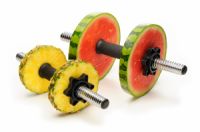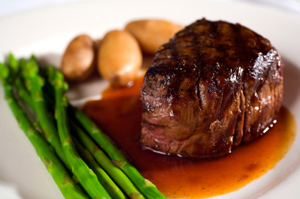Triathlon Nutrition Programming
 A significant component of triathlon training lies in the triathletes’ diet and nutrition. It has been said that a triathlon event is more of an eating contest than it is a foot-race. This is because the body needs to be trained to absorb and process nutrients under conditions of extreme physical activity. Furthermore, it is important to practice proper nutrition techniques outside of racing, as triathletes require a unique diet to excel while performing.
A significant component of triathlon training lies in the triathletes’ diet and nutrition. It has been said that a triathlon event is more of an eating contest than it is a foot-race. This is because the body needs to be trained to absorb and process nutrients under conditions of extreme physical activity. Furthermore, it is important to practice proper nutrition techniques outside of racing, as triathletes require a unique diet to excel while performing.
Components of a proper triathlete’s diet are:
- Adequate caloric intake
- Proper ratio of carbohydrate/protein/fat
- Frequency of food consumption
This guide will provide insight on proper nutritional practices for a successful triathlete.
The Distance Picks the Diet
Obviously, an Ironman-distance triathlon is going to require a considerably higher amount of calories before and during the race than an Olympic-distance event. A common belief is that an average triathlete burns anywhere from 400 to 600 calories per hour during a race. Considering an Ironman triathlon generally takes an average competitor 12 hours to complete, a triathlete will require an average of 6,000 calories just during the race in order to sustain his activity level without running out of fuel, or “bonking.”
Events like the half or full Ironman do require particular nutritional measures to be made during the race. Such measures include:
- Small meals at transition
- Eating while biking or running
- Appropriate hydration throughout all stages of the event
An average Olympic distance triathlon usually takes the average competitor about three hours to complete, meaning that person will only require about 1,500 calories during the race, a significantly less caloric intake compared to the Ironman. Short events like the Sprint or Olympic distance triathlons don’t require the caloric consumption protocols during a race that an Ironman does.
Tri-friendly Eating Habits
 Maintaining an adequate and well-balanced diet is extremely important for all triathletes, especially while training. With all the effort devoted to training, a triathlete needs to have the maximum amount of energy for expenditure. This means that the triathlete requires a well-maintained dietary practice each day, including frequent meals and proper carbohydrate/protein/fat intake.
Maintaining an adequate and well-balanced diet is extremely important for all triathletes, especially while training. With all the effort devoted to training, a triathlete needs to have the maximum amount of energy for expenditure. This means that the triathlete requires a well-maintained dietary practice each day, including frequent meals and proper carbohydrate/protein/fat intake.
Frequency of meals differs from triathlete to triathlete, but it’s generally in a triathlete’s best interest to eat approximately 300 to 500 calories every three-to-four hours, for two main reasons:
- It ensures both adequate caloric consumption and an adequate caloric absorption rate.
- It is a far more efficient practice than infrequent meals of greater proportions, as the body will be unable to process too many calories at once and store the remainder as fat, as opposed to readily accessible fuel.
Compare this idea to the routine of watering a plant: Too much water and the plant floods, wasting excess water. However, watering the plant frequently and consistently results in superior absorption, wasting little water.
A common misconception for endurance athletes is that they should “carbo-load,” which is the term for loading up on just carbohydrates the night before the race. However, this tactic is not completely effective, as it could result in a glycogen intake overload and also place the body in a fat/protein deficit.
Another important component of pre-race nutrition is a sufficient carbohydrate/protein/fat ratio of consumption. A common nutritional ratio throughout the triathlon community is 40/30/30, due to its ample balance of all three nutrients. However, some triathletes may require more of one nutrient and less of another.
Many triathletes are beginning to lean on a higher fat consumption than carbohydrate, due to the efficiency of fat as an energy source. Ultimately, the best way for triathletes to figure out their own ideal nutritional balance is by experimenting with nutrition just as they would with swimming, biking, or running tactics.
Race-day Nutrition
Proper nutrition on race day is perhaps as important as training and equipment. Food is fuel; if you don’t fuel yourself effectively, your energy levels will be insufficient. Eating improperly or unwisely is just as detrimental as trying to compete with inadequate equipment.
Timing is Important
Race-day nutrition actually begins the night before the race, starting with a well-balanced dinner. This dinner should include adequate protein, complex carbohydrates, and monounsaturated fats. Eating an appropriately-sized dinner is also important, as one needs to be sure to consume enough calories to be energized for the upcoming race. At the same time, racers must be sure to not consume too many calories, as that can bog them down or effect their breakfast consumption the following morning.
The Most Important Meal
The morning of the event should begin with a hardy breakfast, similar to dinner in regards to a balanced carbohydrate/protein/fat ratio. Triathlons traditionally begin in the early morning, between 5 and 7 a.m. For that reason, breakfast should be consumed extremely early, generally about two hours before the race begins. It is also wise to bring along a small snack to consume just before the race begins. This snack should primarily consist of simple carbohydrates, such as sugar, so it enters the bloodstream and spikes energy levels faster than complex carbohydrates.
Stay Hydrated
Another component of an effective meal is sufficient hydration: Half one’s bodyweight in ounces, plus an extra 10 ounces due to the increased level of physical activity. Maintaining proper hydration is extremely important for peak performance, as one percent of bodily dehydration can result up to 10 percent of decreased performance. With the intention of maintaining proper hydration, a pre-race meal that is high in sodium will help the body retain water.
Eating on the Go
Caloric consumption and hydration during the event is just as important as it is before. Depending on the length of the event, one’s fueling tactics will vary. However, it is wise to prepare about 400 calories for each hour of racing:
- In the middle of a race, the best type of food to eat are simple carbohydrates, such as a power gel or white cracker, as it enters the bloodstream much faster than other foods.
- If the event is over three or four hours long, one should consider a fuel source that consists of carbohydrates, protein, and fat.
- Some triathletes can digest solid foods while racing without any problems; others will develop indigestion and consequently, will only consume fuel in liquid form, such as a drink, shake, or juice.
Hydration is obviously also critical while racing. Generally, triathletes will hydrate with two types of liquids: Water and sports drinks. It is best if a participant can utilize both liquid sources intermittingly while racing, as water expands the cells and electrolyte-heavy sports drinks shrink the cells. Both liquids have their own unique advantages, so it’s best to switch between the two drinks rather than pick one over the other.
Cycling is the primary opportunity for fuel consumption, as the body is in its most passive state compared to the other legs of the event. Balancing a steady cycling cadence along with the consumption of food or drink requires a bit of training, but it definitely has its advantages over fueling at transition. While cycling, a triathlete should constantly feed oneself with liquid, whether it's with water or a sports drink. Eating depends on the triathletes’ current performance and how they feel, but it is common to have a snack during the beginning of the biking leg, and another one at the end, ensuring the triathlete stays energized through the cycling portion and into the running leg.
Post-race Nutrition
Typically, triathletes finish a race absolutely famished. Consequently, they will devour as much of the complementary food as possible. Events generally provide competitors with a variety of fruits, drinks, and carbohydrate-related dishes (usually pizza). Most triathletes will continue through the finish line and head right to a buffet-style feast nearby. Although it may be a primary instinct to grab the largest slice of pizza available, one should try to resist these temptations and just stick to hydration and fruit. After approximately 15 to 20 minutes has elapsed, you should start consume protein and complex carbohydrate-rich food to alleviate as much lactic buildup and muscle fatigue/soreness as possible. Again, adequate hydration remains of the upmost importance.
It’s an Eating Game
With the intensity and duration of a triathlon, it is no surprise that effective nutrition is so imperative. Similar to the relentless physical training a triathlete invests into adequate race-day preparation, one should also practice proper dieting, so that they may be prepared for race-day caloric consumption. All triathletes are different and there is no definitive recourse in regards to set meal plans or what to consume; it takes dietary practice and experimenting to find the right balance. However, once that ideal fueling state has been achieved, a triathlete can rest assured that they can compete at their highest level of performance.
